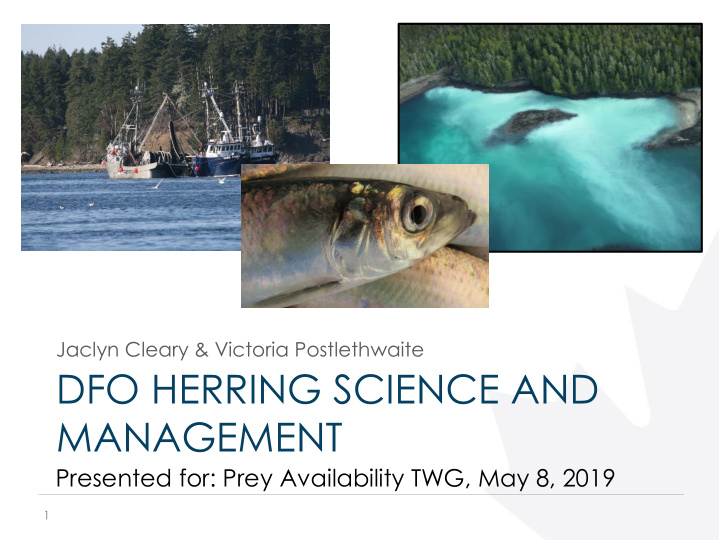



Jaclyn Cleary & Victoria Postlethwaite DFO HERRING SCIENCE AND MANAGEMENT Presented for: Prey Availability TWG, May 8, 2019 1
Annual data and stock assessment programs are conducted coast- wide 5 major and 2 minor stock assessment areas 2
Southern BC Herring stocks Recent 10 years, the main migratory stock spawns Past 15 years, low primarily in Areas spawning levels in 14 & 17N; little to no Esperanza/ spawning below Nuchatlaht; Dodd Narrows Hesquiat/Ahousat; Barkley Sound 3
Herring Migratory Patterns Spring spawning Summer feeding (inshore) (offshore) SOG • General migratory pattern is for age 2+ herring to move out of SOG post spawning (April/May) and move into the west coast feeding areas • Juvenile herring are thought to remain within the Strait of Georgia until at age 2 WCVI herring share feeding grounds with SOG stock (May – Oct) 4
Herring Science Key Programs Annual data collections • • Spawn survey, Biological samples, Catch data Annual stock assessment (Fall) • • Stock trends, herring spawn distribution • Current stock status, 1-year projections Herring MSE • • Objectives and management procedures 5
Herring Stock Assessment: goal of stock assessment is to describe past and current status of a fish stock, make predictions about the future in order to make recommendations for sustainable harvest levels minus Deaths (mortality and Number of catch) Forecast Implement fish; D A T A for next decision current spring rules biomass plus New arrivals Is area ‘model’ open/closed? What is TAC? 6
Strait of Georgia herring: stock trends and reference points Spawning biomass + 90% confidence interval Long- term average biomass LRP (0.3B 0 ) + 90% CI 7
SOG Spawn Distribution Over Time Recent spawn concentrating in 14 & 17N relative to historical periods. 2017 2001-2010 2010 1971-1980* *Change in survey methods makes it hard to differentiate changes attributable to changes in survey methods, and those which are biological*
WCVI herring: stock trends and reference points Spawning biomass + 90% confidence interval LRP (0.3B 0 ) + 90% CI 1950 ‘60 ‘70 ’ 80 ‘90 2000 ’ 10 2018 9
WCVI Spawn Distribution 2010s 1950s 10
Annual assessment advice includes: • Science advice on: • Biomass trends and herring distribution • Biology (size and age structure) • 1-year biomass forecasts and recommendations for sustainable harvest levels • Communication of uncertainty and risk, e.g.: • Biomass + confidence intervals • Probability of avoiding conservation limits 11
Incorporation of Science Advice • Fisheries management receives annual science advice on 5 major herring stock assessment areas • Stock biomass and forecast • Stock levels compared to biological reference points (LRP) • Catch calculation from application of management procedures (previously decision tables) • Aims to ensure that advice and subsequent management decisions are robust to uncertainty 12
Incorporation of Science Advice • Management approach incorporated into IFMP • Consultation on harvest levels, commercial allocations, management measures • Through advisory board processes and draft IFMP (mainly in September-December) 13
Herring Advisory Process • Integrated Herring Harvest Planning Committee (IHHPC) • First Nations • Spawn on kelp fishery • Herring Industry Advisory Board • Special use fishery • Marine Conservation Caucus (MCC) • Sport Fishing Advisory Board (SFAB) • Province of BC • Herring Industry Advisory Board (HIAB) • Seine and gillnet representatives • Processors • First Nations – Bilateral meetings • Other groups as needed (e.g. Conservancy Hornby Island) 14
Management Measures • Harvest levels • MSE results to date support continued application of the 20% harvest rate for the current biomass level in the Strait of Georgia • West Coast of Vancouver Island remained closed to support stock rebuilding • Open areas • Closure of areas where there is an absence of spawning herring • Closure of First Nations FSC harvest areas 15
Research • Interplay of food supply and predation impact on herring survival and production is complex and not readily predictable (Schweigert et al. 2010) • Biological reference points (limit reference point, upper stock reference point) have been developed • Application of the LRP has been completed • Renewal of the management system is ongoing, including a Management Strategy Evaluation process (first cycle complete for SOG and WCVI) 16
Recommend
More recommend